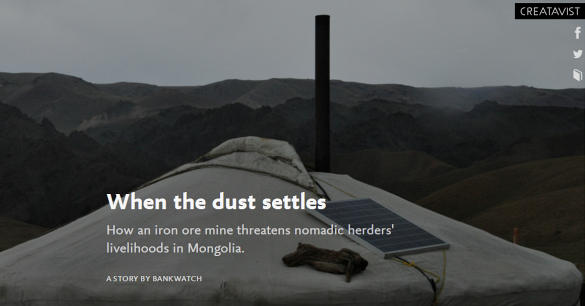Herders from the Gobi Altai mountains in western Mongolia have filed a complaint with the European Bank for Reconstruction and Development (EBRD). The complaint addresses the company Altain Khuder, which at its Tayan Nuur iron ore mine has allegedly caused significant environmental pollution and the displacement of herders in the Mongolian Gobi Altai mountains.
Anne Schuit, SOMO researcher | 21 January 2015

Anne Schuit is a researcher at the corporate watchdog SOMO. Her work focuses on grievance mechanisms.
The independent accountability mechanism of the EBRD, which has invested in the company, accepted the complaint last week. You can download a pdf version of the complaint.
The complaint, filed by seven individuals on 29 December 2014 at the EBRD’s Project Complaint Mechanism (PCM), alleges that the environmental and social impacts of Altain Khuder’s mine are inconsistent with EBRD’s policies. Herders have brought these impacts to the attention of the company on numerous occasions but rather than solving the problems the company has reacted with intimidation and legal action.
Displacement
While the herders have a nomadic lifestyle and migrate with their livestock and ger (traditional tent), they have customary grazing arrangements and a fixed winter location to which they return to survive the harsh weather conditions. Contrary to the requirements of the EBRD, the mining company has not provided them with suitable alternative resettlement sites. Some herders have received monetary compensation but this has not enabled them to access new land.
Sukhgerel Dugersuren from the Mongolian NGO OT Watch explains:
“In many places in Mongolia land is held and managed as common property, meaning that resettled herders cannot use the compensation to purchase new land with adequate pasture and a winter camp so crucial to their survival.”
Amibuh, one of the complainants states:
“There are no vacant fertile pastures with adequate water resources. All of the viable pasture is already occupied so there is nowhere else for us to go. Migrating to occupied pastures has negative implications for other herders and livestock already inhabiting the area. Land areas not in use are of inferior grazing quality, and would result in loss of herds and reduced quality of animal products, which are at the basis of our livelihoods.”
More materials
 When the dust settles – How an iron ore mine threatens nomadic herders’ livelihoods in Mongolia
When the dust settles – How an iron ore mine threatens nomadic herders’ livelihoods in Mongolia
Multimedia story | December 9, 2014
Dust, displacement, intimidation – Mongolian herders are under pressure by iron ore mine
Blog post | December 9, 2014
Fact-finding mission report: Impacts of the Tayan Nuur iron ore mine on nomadic herders’ lives in Mongolia (pdf)
Study | December 9, 2014
Impacts of the global iron ore sector – Case study: Altain Khuder in Mongolia (pdf)
SOMO case study | December 17, 2014
Images from Gobi Altai, Monoglia
Flickr photo set
Background
Mining boom in Mongolia
Background, updates, publications
Pollution
Altain Khuder exports the iron ore from the Tayan Nuur mine to China. The gravel roads that are used for the transportation of the ore generate significant environmental pollution. Dust from the road pollutes pastureland and allegedly causes illnesses to herders and their animals. Herders, whose livelihoods depend on their livestock, claim they have lost up to several dozen animals, mainly goats and camels, due to dust-related illnesses. Pollution of air, water and food also creates risks for the health of the herder families.
A paved road is currently being constructed, but herders have not been included in planning of the route and the location of passageways for people and livestock despite the fact that this road cuts through the grazing lands and leads to road safety risks and pasture fragmentation.
Complaint
The herders, supported by OT Watch, the Centre for Research on Multinational Corporations (SOMO) and CEE Bankwatch, request that the Project Complaint Mechanism convenes a dialogue between them and the company to try to resolve issues. The herders request Altain Khuder to fully assess, disclose and adequately address the negative impacts of the mine, including the swift completion of the paved road with adequate overpasses, restoration of degraded and polluted land, and the implementation of a comprehensive livelihood restoration program in consultation with all stakeholders involved. They also request proper compensation for the loss of animals and provision of suitable resettlement locations.
Additionally, the herders request that the Project Complaint Mechanism conducts an investigation into the EBRD’s compliance with its own standards. The social and environmental standards that are included in its investment strategies make the EBRD distinctly different from mainstream investors. The fact that problems of the herders have not been solved suggests that either the EBRD’s environmental and social standards are inadequate, or that their implementation is weak.
The complaint was officially registered on January 15th and will now move on to the next phase. The Project Complaint Mechanism will now consult with all relevant parties in order to determine if it will facilitate a dialogue between the complainants and the company, and if it will conduct an investigation into the EBRD to determine whether the Bank has complied with its owns standards.
Given the severe negative impacts of the mining project on the herders’ lives we hope the PCM will move swiftly so that their concerns can be adequately addressed and livelihoods restored. This is also an opportunity for the PCM to show that independent accountability mechanisms of international development finance institutions play an important role in the field of business and human rights and have the ability to provide remedy for people who otherwise are left without justice.
Never miss an update
We expose the risks of international public finance and bring critical updates from the ground – straight to your inbox.
Institution: EBRD
Theme: Social & economic impacts | Development | Mining
Location: Mongolia
Project: Mining boom in Mongolia
Tags: Altain Khuder | Gobi Altai | Tayan Nuur | mining
